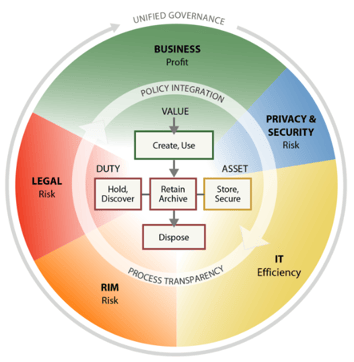Minimizing eDiscovery spend begins with a disciplined information governance (or, in traditional corporate speak, a disciplined document retention plan).
And that begins with a data mapping exercise.
What is a Data Map?
It typically consists of a few basic pieces:
- A guide to where data is stored in your organization
- Associated business units and technology (who creates it? who's in charge of it?)
- Record retention period
Specifically, this is information normally considered discoverable during an investigation or litigation.
It's not necessarily a visual map, per se - it could be as simple as an Excel sheet (a simple Google search will yield lots of results on free templates) or organizations may opt to purchase knowledge management software specifically geared to maintaining disciplined data practices in more complex organizations.
The choice, of course, depends upon the size, complexity, risk, and urgency for your organization.
Data maps are a foundational piece of information governance, in conjunction with document retention policies.
Why Is Data Mapping Important?
The same reason businesses purchase many services:
- Save time during the discovery process
- Save money during discovery and on data storage
- Regulatory compliance
- Enables smarter business operations
When faced with custodian interviews and collections, a data map can quickly point counsel in the right direction and mitigate the chances they overlook someone or something important. This supports the adage, "do it right the first time."
Sure, there's a cost associated with data mapping, but it's spending a dime now to save a dollar later (or more accurately, it saves tens of thousands of dollars, due to the cost of taking a single gigabyte of data from collection through hosting).
Corporations and government entities that store any form of personal identifying information (PII) and/or are subject to laws such as GDPR and CCPA have no excuse to avoid this exercise. More and more states are exploring implementing similar laws. We've been involved in multiple data breach analyses recently, and the lack of a clear understanding within some firms as to where data lives has led to higher costs of custodian interviews, data collection, document review, and data storage.
Finally, data migration and analysis for key insights is strengthened when people know what data is available and where to find it. A well-executed data map may be the key between a smooth ERP or CRM switch and a nightmare experience, or uncovering competitive insights that drive differentiation.
How to Make it Stick
Like all other areas of human behavior, repetition is the key.
- Thorough training and explanation of policies, expectations, and responsibilities
- Consistent communication on the importance and organizational benefit
- Regular updates as new systems become a part of business operations
The importance of an evergreen approach cannot be overemphasized: key employees take on new roles, or leave the organization. New pieces of hardware or software are integrated. Data flows are adjusted.
Stakeholders from across the organization need to be involved, so alignment from the top is crucial. Communicating why the project is being prioritized is critical. Sharing a painful episode from your corporation's own history, or relating an experience of another firm, can make it very tangible and show people how high the stakes are.
And, of course, the best way is to do it right the first time. Identifying a key partner who understands the stakes and turns over every stone is critical in maximizing ROI on your team's time.
If you want to talk through any ideas or are curious about initiating a project.




